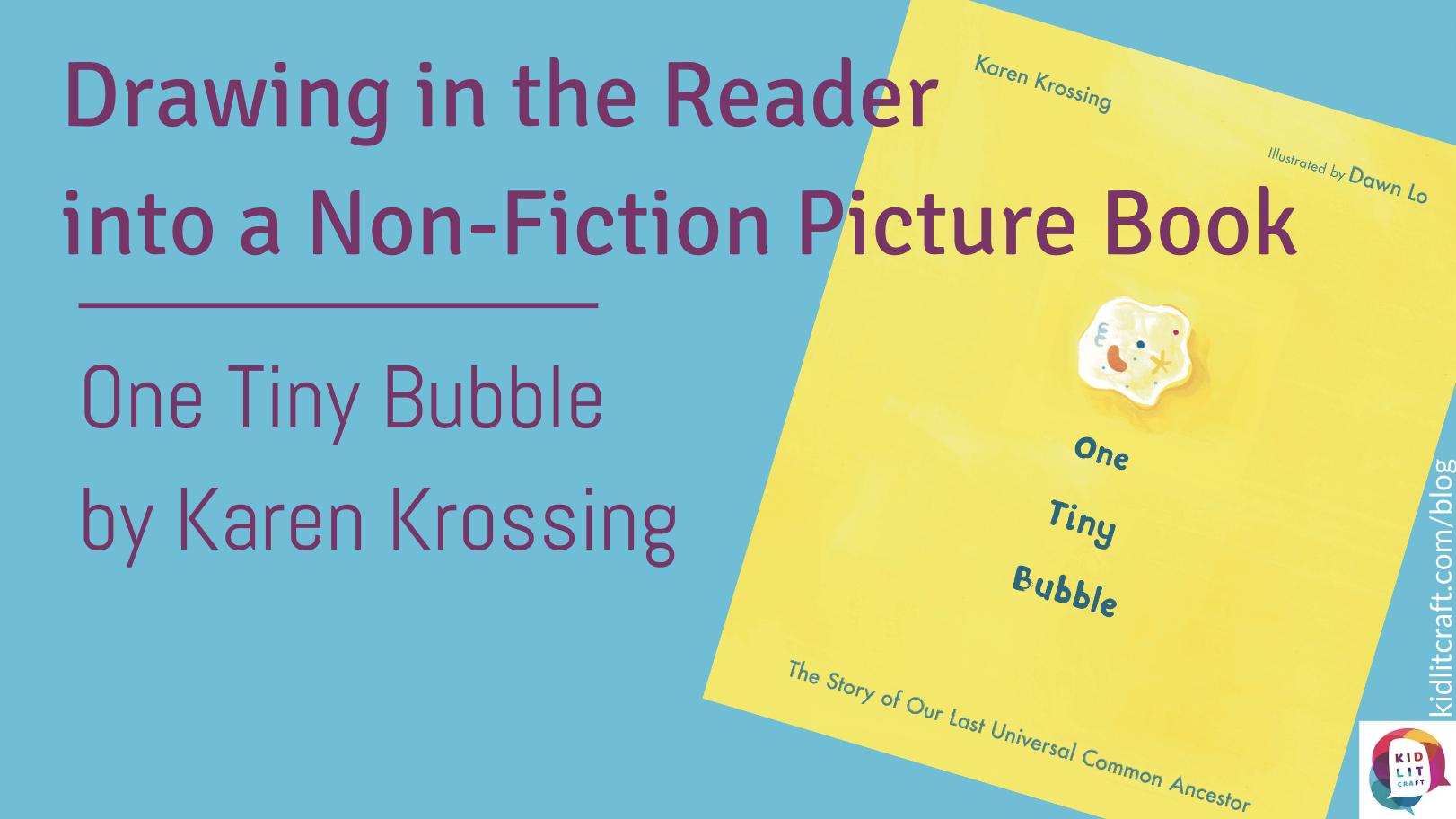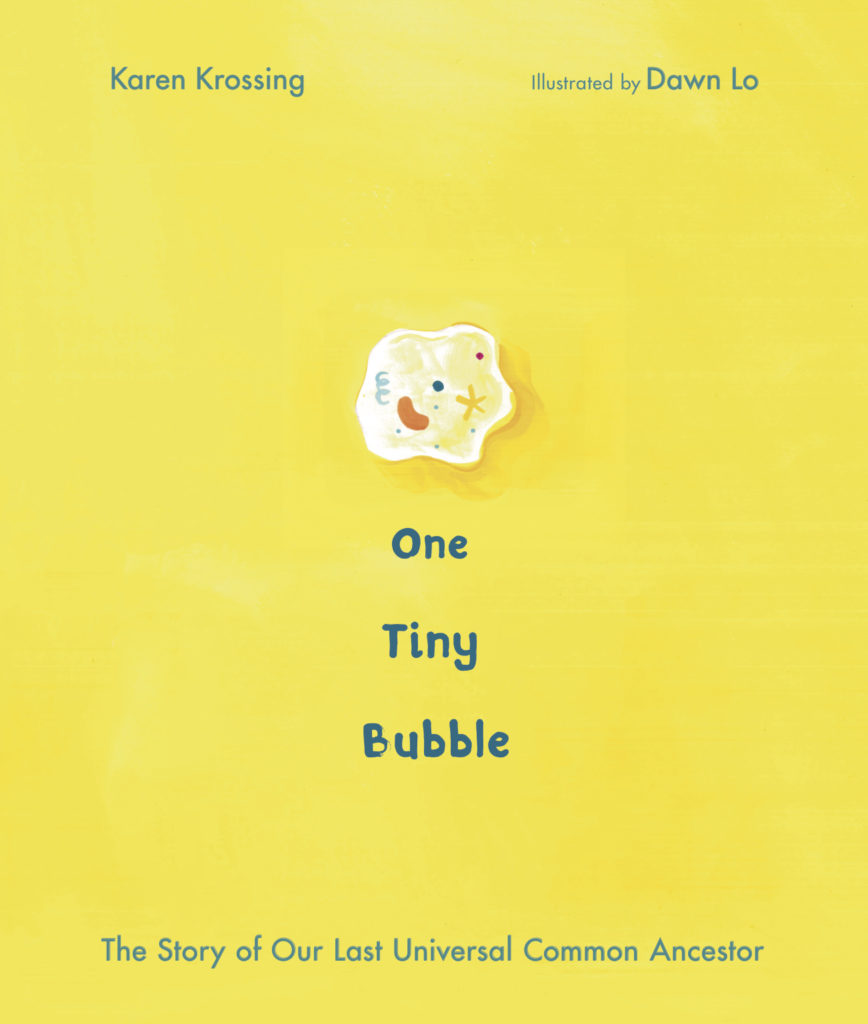craft review by Anne-Marie Strohman
Non-fiction books are meant to provide information to young readers. But many non-fiction books also tell the reader a story. And some of the best non-fiction books go the extra mile to pull readers into that story. Exhibit A: One Tiny Bubble: The Story of Our Last Universal Common Ancestor by Karen Krossing.
One Tiny Bubble tells the story of the first bit of life on earth that came from a mix of the dust of exploded stars, water, and a whole lot of heat. That bit of life–LUCA, the Last Universal Common Ancestor–multiplied and evolved for eons into all the life on the planet as we know it today.
Throughout the story, Krossing uses specific craft techniques to connect readers to the story, from direct address to apt comparisons, enabling kid readers to understand LUCA in relation to themselves and their world. Let’s look at how she does it.
Direct Address
One Tiny Bubble opens with a direct address to the reader: you.
Long, long ago
before you took your first breath
before your parents were born and your grandparents and great-grandparents, too,
even before any dinosaurs hatched or algae began to grow in the seas,
lived your first family member,
LUCA.
Krossing positions LUCA in relation to the reader in time, by using markers young readers can understand–before they were born, and their parents were born. And even before dinosaurs were born.
This way of centering the reader in the story helps young readers connect to an invisible thing, which can feel more like an abstract concept.
Invitation to the Reader
On the next page, Krossing invites the reader to participate in the story:
Imagine Earth way back then,
when meteorites crashed from outer space,
lightning storms flashed [. . .]
This kind of participation keeps readers engaged and stretches them to bend their minds toward this weird little form of life.
Kid-friendly Comparisons
In introducing LUCA, Krossing implies a comparison to the child reader and uses a perfect image to help readers understand the physical qualities of this tiny form of life.
LUCA was a squishy blog with no legs or arms.
No eyes or mouth.
Tinier than a cupcake sprinkle . . .
Kids still have to use their imaginations to conceive of a life-form with none of the typical body parts humans have. And then Krossing offers a great kid-sized comparison: a cupcake sprinkle. It’s a tiny thing that kids can relate to, and they are invited to use their imaginations again to think of a size smaller than this tiny object.
Later, Krossing compares LUCA and the child-reader directly:
LUCA was just one cell
held together by its membrane,
while you are many cells
held together by your skin.
The correspondence between human skin and LUCA membrane can help kids get an even better idea of how LUCA functioned.
Alliteration Galore!
Near the end of the book, Krossing connects the tiny LUCA to life as we know it–in kid-friendly and alliterative ways:
[. . .] ancient algae
and giant dinosaurs
. . . mushrooms and moss,
fir trees and ferns,
bacteria and bedbugs,
sea stars and sharks,
lizards and lions . . .
Kids are likely to have encountered a number of living things on this list, and the alliteration and rhythm will draw kid in, even if the aren’t familiar with them. (And dinosaurs are always a draw!)
Bringing it Back to the Child Reader
At not-quite-the-end, Krossing brings the story back around to the opening time references. LUCA and its descendants have evolved into the things in the section above and
. . . your great-grandparents, your grandparents, your parents, and now . . . you.
You belong to the oldest family on Earth.
The reverse of the opening sequence adds a nice touch, bringing the story full circle. And again, Krossing exploits the relationship between the child-reader and LUCA. Not only does it show the importance of LUCA, but it’s so cool!
Making Meaning for the Child-Reader
I won’t spoil the ending. Hunt down this book and read for yourself how Krossing takes the story the one extra step into magic. You’ll also find myriad other effective craft techniques for writing non-fiction picture books.
The effect of all these craft choices Krossing made in the process of writing One Tiny Bubble is to draw the child-reader into the story and help them conceptualize this strange little being that’s so different from human life as we know it.
Now It’s YOUR Turn!
Whether you’re writing fiction or non-fiction stories, connecting with your reader is essential. Consider trying some of these more direct techniques in your own work.
- Try addressing your reader directly.
- Choose objects of comparison that children are interested in.
- Directly compare with the child.
- Use a list and alliteration to emphasize an element of your story.
- Use a sequence in your opening section, and repeat it in reverse in your closing section.
- Show why your story is meaningful to the reader (possibly through direct address).
For more great KidLit Craft content, check out these interviews and posts about writing non-fiction picture books.
Anne-Marie Strohman (co-editor) writes picture books, middle grade novels, and young adult short stories and novels. She is trained as a teacher, an editor, and a scholar, specializing in Renaissance Literature. She holds an MFA in Writing for Children and Young Adults from Vermont College of Fine Arts and is an active member of SCBWI. Find her at amstrohman.com and on Twitter @amstrwriter.


COMMENTs:
0